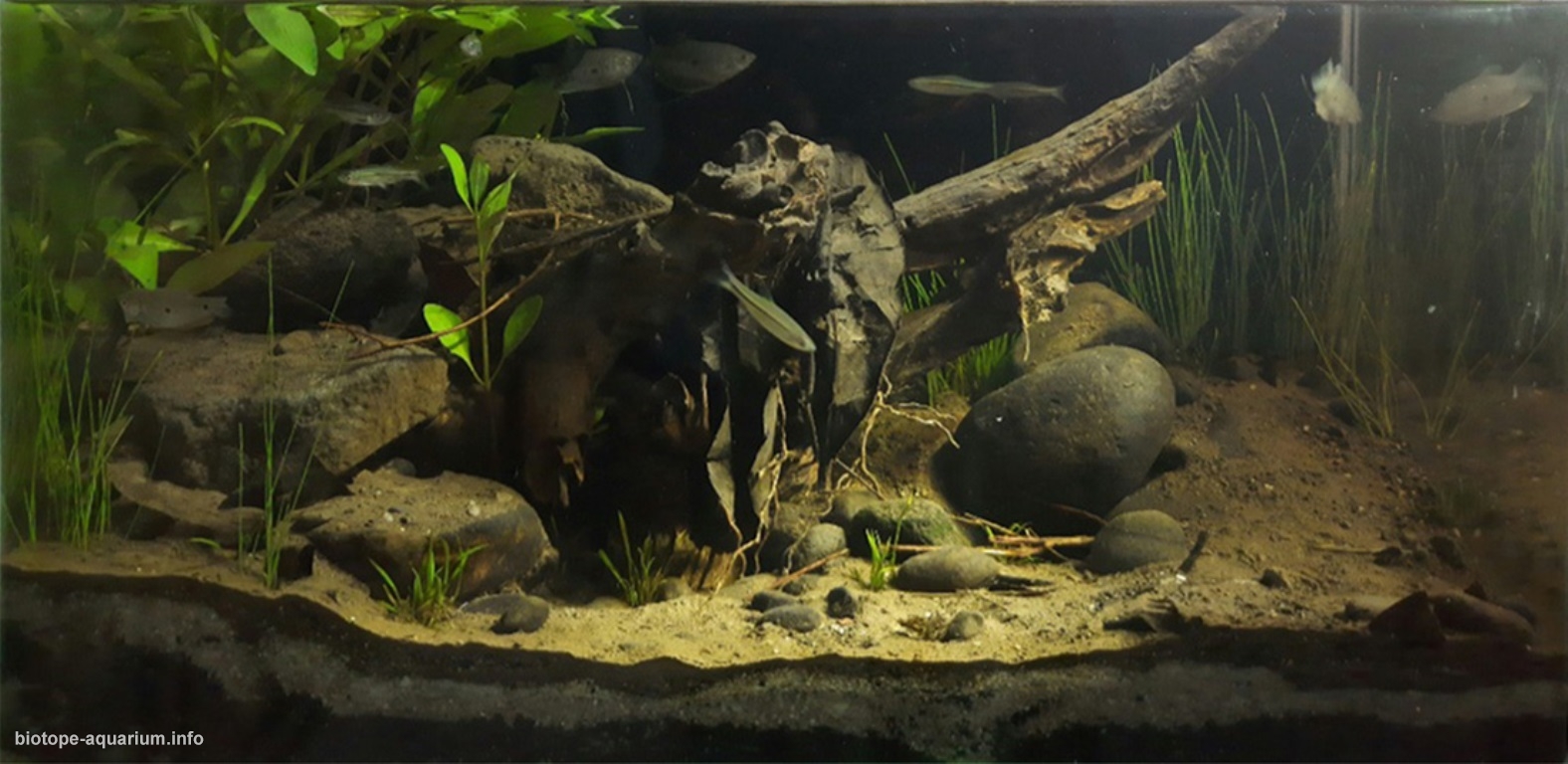The banks of the Silugonggo Pati River, Central Java, Indonesia
_th place in Biotope Aquarium Design Contest 2020

Volume: 54 liter
Dimensions: 60x30x30 cm
List of fishes: Rasbora argyrotaenia,Trichogaster trichopterus.
List of plants: Eleocharis montevidensis,Hygrophila costata,echinodorus tenellus.
Description of decorations: I took all the decorations directly from the Silugonggo river such as driftwood, rocks, sand, mud, dry leaves and tree branches to make them resemble their natural habitat.
Description of equipment: I used a DIY filter tube with the Amara 1200l / h brand, giving a calm flow effect on the riverbanks like in direct nature, with bio crystalline filter media and bio foam foam, while my lighting used a total 12W DIY CUSTOM LED with a ratio of 4W yellow, 6W 6500K white and 2W 30,000k white to give a sun-reflecting effect.
Water parameters: Water slightly brownish yellow, temperature 30 ° C pH 7.9 TDS is 329.
Additional info: I change 60% of the water once a month, and I often clean the mossy glass so that the tank looks clean and easy for everyone to see.
INFORMATION ABOUT BIOTOPE
Description of the area surrounding the biotope: Silugonggo River has a length of 61 km with a cross-sectional width of the river 60-100 m and the depth varies from approximately 2 meters to 5 meters and has 26 tributaries that protect 8 sub-districts in Pati Regency. The coordinate is -6.733309,111.104694. Many things happen in the Silugonggo river, which is located in the city of pati, juwana sub-district. During the dry season, the accumulation of mud resembles an island in the middle of a river. This silting becomes wet when the rainfall is high. When the rainy season arrives, the Silugonggo river always overflows. The impact was extraordinary. Not only the people on the banks of the river but also closed access to southern Pati. Even in 2008 and 2012, the link between juwana and starch was paralyzed. The estuary of the Silugonggo River is the mouth of a large and long river in the pati district. The mouth of the Silugonggo River crosses the City of Juwana, Pati Regency, Central Java, Indonesia. This river empties into the Java Sea and leads to the southwest through Juwana City, Jakenan District, Pati Kota District, Gabus District, Kayen Undaan District, Kudus Regency until it empties into Babalan W Gedung Demak Regency. In Babalan the Juwana River meets the Serang River or the Lusi River which empties into the Kedungombo Reservoir. Because it is connected to the Kedungombo Reservoir, this is one of the causes of frequent overflowing of the Juwana River or the Silugonggo River Estuary.
Description of the underwater landscape of the biotope: The bottom of the riverbank is muddy and there are also some rocks, tree branches, driftwood overgrown with algae and several types of plants such as Hygrophila costata,Eleocharis montevidensis and Echinodorus tenellus. After the air is about 2 to 5 meters deep, the bottom is completely covered with mud. Most of the small fish there are found on the river bank.
Description of the parameters of the habitat: Indonesia is a country in Southeast Asia which is crossed by the equator and is located between the mainland continents of Asia and Australia, and between the Pacific Ocean and Indian Ocean, Indonesia has 2 seasons, namely the dry season and the rainy season. The rainy season in Indonesia occurs due to the blowing of the west monsoon and occurs between September and March. The rainy season in Indonesia lasts from October to February. In some areas, the rainfall is often so heavy that it floods.
The dry season takes place in Indonesia along with the blowing of the eastern monsoon and occurs between March and September. However, in March and September, there is a possibility that the rain will still fall due to erratic wind movements. The dry season in Indonesia mostly lasts from April to September. During the dry season, the water temperature in the silugonggo river is between 28 ° C and 31 ° C. The pH of the water varies from 7.7 to 8.3. The TDS is 329 and the colir of the water is slightly brownish yellow.
List of fishes and invertebrates occurring in the nature biotope: Trichogaster trichopterus, Rasbora argyrotaenia, Gambusia affinis (Spesies invasif), Glyptoperichthys gibbiceps (Spesies invasif), Poecilia reticulata (Spesies invasif), Pterygoplichthys spp (Spesies invasif), Anabas testudineus (Spesies invasif), Penaeus merguiensis, Plotosidae, Channa melanoptera, Oreochromis mossambicus (Spesies invasif), Oreochromis niloticus (Spesies invasif), Channa pleurophthalmus.
List of plants found in the nature biotope: Pennisetum purpureum, Echinodorus tenellus, Hemarthria altissima, Eichhornia crassipes, lpomoea aquatica forsk, lpomoea obscura, Imperata cylindrica, Thysanolaena latifolia, Eleocharis montevidensis, Pistia stratiotes, Hygrophila costata.
Threats to the ecology: When my friend and I saw the scene at the silugonggo river site, many people dumped garbage in the river and there was also a flow of waste from the factory in the vicinity that went directly to the river, when this situation continues for the next few years this is very dangerous for survival these beautiful fish. I can’t stop it all because they don’t care even they are used to seeing rubbish drifting under the river flow, so I want to show everyone that there is the most beautiful view under the river flow if you continue to pollute the river with your trash. Most likely our children and grandchildren will not be able to see the beautiful small fish and the natural nature under the river flow.
Sources of information:
https://www.kabarkotapati.com/
https://id.m.wikipedia.org/
https://www.direktoripati.com/
http://pojokpati.blogspot.com/
https://www.wikiwand.com/id/
